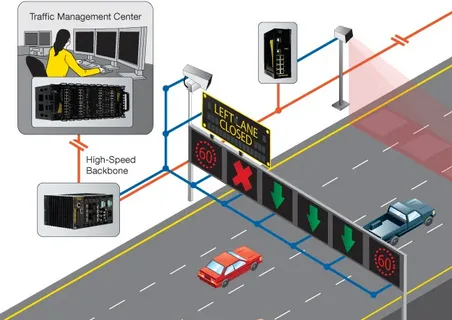Managing lighting in high-traffic areas can be a real headache. These busy spaces demand flexible illumination that adapts to changing conditions throughout the day. Traditional lighting systems often fall short, wasting energy and failing to provide optimal light levels when and where needed.
Wireless lighting controls offer numerous benefits, including energy savings and improved comfort. Before implementation, it’s crucial to assess your space, considering factors like traffic patterns and natural light sources. This evaluation helps determine the right components for your wireless network.
But the question is, how to set up wireless lighting controls in high-traffic areas? What are the benefits, and what else should you know? I have discussed all this and more in the article below.
Table of Contents
Basic Concept of Wireless Lighting Controls
Let’s start with understanding what wireless lighting controls are and how they work. These systems help you control your lights without needing lots of wires. Instead, they use special signals that travel through the air to talk between different parts of the system. This makes it easier to put in place and change around when needed.
Benefits of Wireless Lighting in High-traffic Areas
Implementing wireless lighting controls in busy spaces offers several advantages:
- Flexibility: Easily adjust lighting configurations without rewiring
- Energy efficiency: Optimize lighting usage based on occupancy and natural light
- Convenience: Control lights remotely using smartphones or tablets
- Scalability: Add or remove lighting fixtures as needed without major renovations
Planning Your Wireless Lighting Setup
Before you start installing anything, it’s important to have a good plan. Planning helps you avoid problems later and makes sure your new lights work well. Let’s look at what you need to think about when setting up your wireless lighting system.
Assess Your Space
Start by evaluating the high-traffic area where you want to install the lighting controls. Consider factors such as:
- Size and layout of the space
- Natural light sources
- Peak hours of activity
- Specific lighting needs for different zones
Choose Your System
Select a wireless lighting control system that suits your requirements. Look for features like:
- Compatibility with existing fixtures
- User-friendly interfaces
- Range of control options (dimming, scheduling, scene setting)
- Integration with other smart home systems
Components of Wireless Lighting Networks
A typical wireless lighting setup consists of several key components:
- Smart bulbs or fixtures
- Wireless controllers or switches
- Hub or gateway device
- Sensors (motion, occupancy, daylight)
- Mobile app or control software
Step-by-Step Installation Guide
Now that we understand the basics, let’s walk through how to set up your lights step by step. At first wireless lighting control systems might seem tricky, but don’t worry. I’ll break it down into easy-to-follow steps. It will help you install your new lighting controls without any fuss. Let’s get started.
1. Install the Hub
Begin by setting up the central hub or gateway of your wireless lighting system. This device acts as the brain of your network, coordinating communication between all components.
2. Replace or Retrofit Existing Fixtures
Depending on your chosen system, either replace your current light fixtures with smart ones or add wireless receivers to make existing fixtures compatible.
3. Set Up Wireless Switches and Sensors
Install wireless switches and sensors throughout the high-traffic area. Place motion sensors in key locations to detect movement and trigger lighting changes automatically.
4. Configure the Network
Use the system’s app or software to connect all devices to your wireless lighting networks. Follow the manufacturer’s instructions to ensure proper pairing and communication.
5. Create Zones and Scenes
Divide your high-traffic area into logical zones based on usage patterns. Then, create lighting scenes for different scenarios, such as “daytime,” “evening,” or “cleaning mode.”
6. Program Schedules and Automation
Set up schedules to automatically adjust lighting based on time of day or occupancy patterns. This step is crucial for maximizing energy efficiency in busy areas.
7. Test and Adjust
Thoroughly test your new wireless lighting control system. Make adjustments to sensor sensitivity, timing, and scene settings as needed to optimize performance.
Best Practices for High-Traffic Areas
To ensure your wireless lighting controls work effectively in busy spaces, consider these tips:
- Use occupancy sensors with short time-out periods to quickly turn off lights in unoccupied areas
- Implement daylight harvesting to take advantage of natural light and reduce energy consumption
- Create task-specific lighting scenes for different activities that may occur in the space
- Regularly update your system’s firmware to ensure optimal performance and security
Troubleshooting Common Issues
Even with careful planning, you may face some challenges. Here are solutions to common problems:
- Interference: If devices aren’t responding, try changing the wireless channel or relocating the hub
- Limited range: Add signal repeaters to extend the network’s coverage in larger spaces
- Unresponsive fixtures: Check battery levels in wireless switches or sensors, and ensure all devices are properly connected to the network
Conclusion
Setting up wireless lighting controls in high-traffic areas can significantly improve energy efficiency, convenience, and ambiance. By carefully planning your system, choosing the right components, and following best practices, you can create a responsive and effective lighting solution for even the busiest spaces. As technology continues to advance, these systems will play an increasingly important role in smart building management, offering effective control and customization for lighting in all types of environments.
